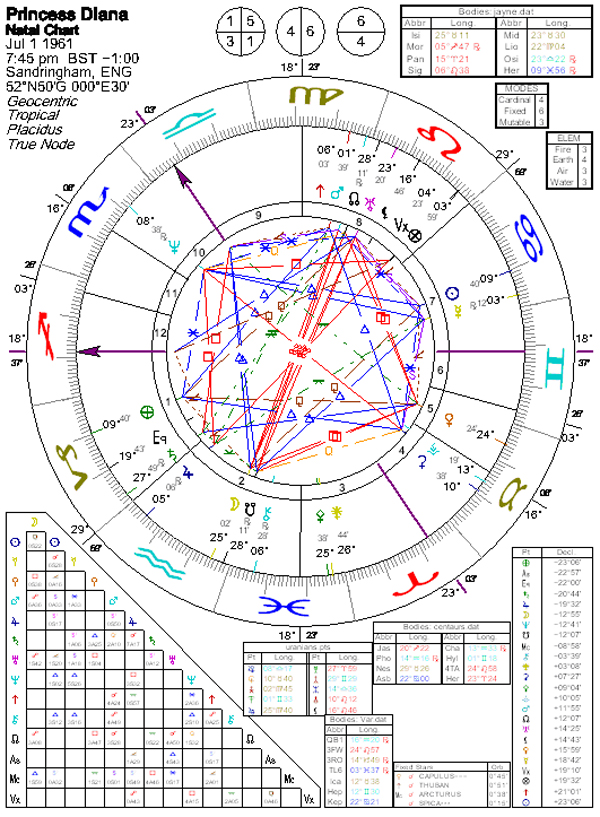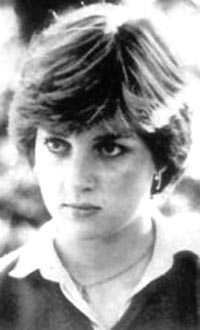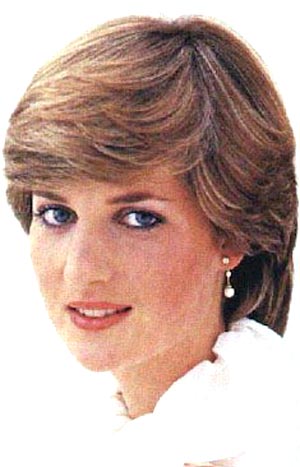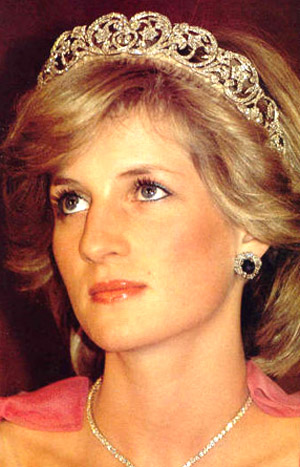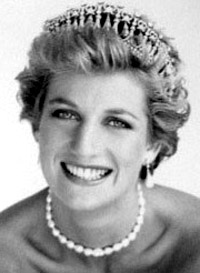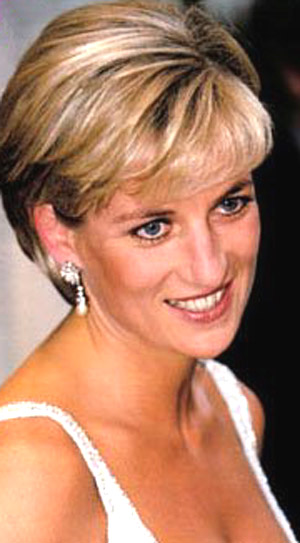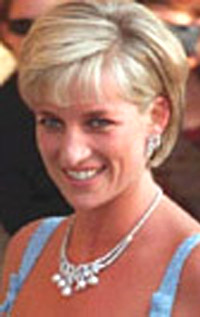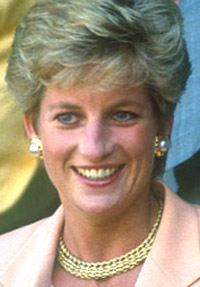Princess Diana
Copyright Michael D. Robbins 2005
Astro-Rayological
Interpretation & Charts
Quotes
Biography
Images and Physiognomic Interpretation
Diana—Daughter of the Eighth Earl of Spencer:
July 1, 1961, Sandringham, England, 7:45 PM, BST. (Source: her mother) Died, August 31, 1997, 1:50 AM, Paris, France
(Ascendant, Sagittarius, Sun and Mercury in Cancer; Moon and Jupiter in Aquarius; Venus in Taurus, Mars and Pluto in Virgo; Saturn in Capricorn; Uranus in Leo; Neptune in Scorpio)
“Princess Di” was one of the greatest of world celebrities, at first because of her marriage to Prince Charles (a kind of “fairy-tale marriage”), but even moreso (even after their marriage fell into difficulty and finally dissolved) as she emerged as a great political and social force for humanitarianism and world goodwill. She was known for her genuineness, personableness, compassion, her common touch (Cancer Sun), her international perspective (Sagittarius, Ascendant), and her emerging spirituality (Neptune, esoteric ruler of the Cancer Sun, elevated in the 10th house).
She seemed to touch the hearts of all humanity, and indication of the power of the second ray of Love-Wisdom, and her tragic and sudden death in an automobile accident (Uranus in H8 opposed Moon {ruler of H8} in Aquarius), with Mars in Virgo also opposed to the Moon) united the world consciousness in love and appreciation. Her influence was clearly global and beneficent (second ray Jupiter in Aquarius).
I know it’s just a job they have to do, but sometimes I do wish they wouldn’t.
On photographers who followed her during her engagement to Prince Charles, NY Times 25 Feb 81Any sane person would have left long ago. But I cannot. I have my sons.
(Venus in Taurus in 5th house.)Anywhere I see suffering, that is where I want to be, doing what I can.
(Chiron in Pisces in 2nd house; Neptune in 10th house; Mercury in Cancer conjunct Sun.)Being a princess isn't all it's cracked up to be.
Carry out a random act of kindness, with no expectation of reward, safe in the knowledge that one day someone might do the same for you.
Don't call me an icon. I'm just a mother trying to help.
Everyone needs to be valued. Everyone has the potential to give something back.
(Moon & Jupiter in Aquarius in 2nd house.)Family is the most important thing in the world.
(Cancer Sun; Venus in Taurus in 5th house.)Helping people in need is a good and essential part of my life, a kind of destiny.
(Neptune in 10th house.)I don't even know how to use a parking meter, let alone a phone box.
I don't want expensive gifts; I don't want to be bought. I have everything I want. I just want someone to be there for me, to make me feel safe and secure.
I have a woman's instinct and it's always a good one.
I know that I can give love for a minute, for half an hour; for a day, for a month, but I can give and I'm very happy to do that and I want to do that.
I like to be a free spirit. Some don't like that, but that's the way I am.
I live for my sons. I would be lost without them.
I love to hold people's hands when I visit hospitals, even though they are shocked because they haven't experienced anything like it before, but to me it is a normal thing to do.
I think like any marriage, especially when you've had divorced parents like myself; you want to try even harder to make it work.
I think the biggest disease the world suffers from in this day and age is the disease of people feeling unloved. I know that I can give love for a minute, for half an hour, for a day, for a month, but I can give. I am very happy to do that, I want to do that.
I understand people's suffering, people's pain, more than you will ever know yourself.
I want my boys to have an understanding of people's emotions, their insecurities, people's distress, and their hopes and dreams.
I want to walk into a room, be it a hospital for the dying or a hospital for the sick children, and feel that I am needed. I want to do, not just to be.
I wear my heart on my sleeve.
I will fight for my children on any level so they can reach their potential as human beings and in their public duties.
(Venus in Taurus in 5th house square Mars/Pluto in 8th house.)I wish all the mothers, fathers and children out there realize how much I need them and how much I value their support.
I'd like people to think of me as someone who cares about them.
I'd like to be a queen in people's hearts but I don't see myself being queen of this country.
I'm as thick as a plank.
I'm aware that people I have loved and have died and are in the spirit world looking after me.
I've got to have a place where I can find peace of mind.
If I am to care for people in hospital I really must know every aspect of their treatment and to understand their suffering.
It is a weakness that I lead from my heart, and not my head?
My first thoughts are that I should not let people down, that I should support them and love them.
Nothing brings me more happiness than trying to help the most vulnerable people in society. It is a goal and an essential part of my life - a kind of destiny. Whoever is in distress can call on me. I will come running wherever they are.
Only do what your heart tells you.
The greatest problem in the world today is intolerance. Everyone is so intolerant of each other.
The people that I care about are the people out there on the street. I can identify with them.
(Moon in Aquarius in 2nd house.)There were three of us in this marriage, so it was a bit crowded.
They say it is better to be poor and happy than rich and miserable, but how about a compromise like moderately rich and just moody?
This boy is dead now, I knew it before taking him in my arms, I can remember his face, his suffering, his voice.
What must it be like for a little boy to read that daddy never loved mummy?
When you are happy you can forgive a great deal.
Whoever is in the distress can call me. I will come running wherever they are.
Yes, I do touch. I believe that everyone needs that.
You can't comfort the afflicted with afflicting the comfortable.
I am not a political figure. The fact is I am a humanitarian figure and always will be.
Perhaps we're too embarrassed to change or too frightened of the consequences of showing that we actually care. But why not risk it anyway? Begin Today. Carry out a random act of seemingly senseless kindness, with no expectation or reward or punishment. Safe in the knowledge that one day, someone somewhere might do the same for you.
I knew what my job was; it was to go out and meet the people and love them.
No one sat me down with a piece of paper and said, “This is what is expected of you. But… I’m lucky enough in the fact that I have found my role… I love being with people.
“It's vital that the monarchy keeps in touch with the people. It's what I try and do.”
When we had William, we had to find a date in the diary that suited Charles and his polo. William had to be induced because I couldn't handle the press pressure any longer.
Diana, Princess of Wales
Born 1 July 1961 Sandringham, Norfolk, England
Died 31 August 1997 Paris, France
The Lady Diana Frances Spencer (Diana Frances Mountbatten-Windsor, née Spencer) (July 1, 1961–August 31, 1997) was the first wife of Charles, Prince of Wales. From her marriage in 1981 to her divorce in 1996 she was styled Her Royal Highness The Princess of Wales. After her divorce from the Prince of Wales in 1996 Diana ceased to be the Princess of Wales and also lost the resulting Royal Highness style (although many still speak of her as HRH Princess Diana) She received the form of title normally used by ex-wives of peers, Diana, Princess of Wales under Letters Patent issued by Queen Elizabeth II at the time of the divorce.Diana was often called Princess Diana by the media and the public, but she did not possess such a title and was not personally a princess, a point Diana herself made to people who referred to her as such. Contrary to belief, being Princess of Wales does not make one a princess in one's own right. It merely indicates that one was married to a Prince of Wales. Princesses in their own right only exist by creation of the monarch or by birth. Diana was in fact the first non-princess to be Princess of Wales for centuries. Previous Princesses of Wales, such as Alexandra of Denmark or Mary of Teck were already princesses by birth when they married a Prince of Wales.
An iconic presence on the world-stage, Diana, Princess of Wales was noted for her pioneering charity work. Yet her philanthropic endeavours were overshadowed by her scandal-plagued marriage to Prince Charles. Her bitter accusations via friends and biographers of adultery, mental cruelty and emotional distress visited upon her, and her own admission of adultery and numerous love affairs riveted the world for much of the 1990s, spawning books, magazine articles and television movies.
From the time of her engagement to the Prince of Wales in 1981 until her death in a car accident in 1997, the Princess was arguably the most famous woman in the world, the pre-eminent female celebrity of her generation: a fashion icon, an image of feminine beauty, admired and emulated for her high-profile involvement in AIDS issues and the international campaign against landmines. During her lifetime, she was often referred to as the most photographed person in the world. To her admirers, The Princess of Wales was a role model — after her death, there were even calls for her to be nominated for sainthood — while her detractors saw her life as a cautionary tale of how an obsession with publicity can ultimately destroy an individual.
The Honourable Diana Frances Spencer was born as the youngest daughter of Edward Spencer, Viscount Althorp, and his first wife, Frances Spencer, Viscountess Althorp (formerly the Honourable Frances Burke Roche) at Park House on the Sandringham estate. She was baptised at St. Mary Magdalene Church in Sandringham, by Rt. Rev. Percy Herbert (rector of the church and former Bishop of Norwich and Blackburn); her godparents included John Floyd (the chairman of Christie's) and Mary Colman (a niece of the Queen Mother). Partially American in ancestry — a great-grandmother was the American heiress Frances Work — she was also a descendant of King Charles I. During her parents' acrimonious divorce over Lady Althorp's adultery with wallpaper heir Peter Shand Kydd, Diana's mother sued for custody of her children, but Lord Althorp's rank, aided by Lady Althorp's mother's testimony against her daughter during the trial, meant custody of Diana and her brother was awarded to their father. On the death of her paternal grandfather, Albert Spencer, 7th Earl Spencer, in 1975, Diana's father became the 8th Earl Spencer, and she acquired the courtesy title of The Lady Diana Spencer and moved from her childhood home at Park House to her family's sixteenth-century ancestral home of Althorp. A year later, Lord Spencer married Raine, Countess of Dartmouth, the only daughter of the romance novelist Barbara Cartland, after being named as the "other party" in the Earl and Countess of Dartmouth's divorce.
Diana was educated at Riddlesworth Hall in Norfolk and at West Heath Girls' School (later reorganized as the New School at West Heath, a special school for boys and girls) in Sevenoaks, Kent, where she was regarded as an academically below-average student, having failed all of her O-level examinations. In 1977, aged 16, she left West Heath and briefly attended Institut Alpin Videmanette, a finishing school in Rougemont, Switzerland (Diana's future husband was also dating her sister, Lady Sarah at that time). Diana was a talented amateur pianist, excelled in sports and reportedly longed to be a ballerina.
Diana's family, the Spencers, had been close to the British Royal Family for decades. Her maternal grandmother, Ruth, Lady Fermoy, was a longtime friend of, and a lady-in-waiting to Queen Elizabeth the Queen Mother.
The Prince's love life had always been the subject of press speculation, and he was linked to numerous women. Nearing his mid-thirties, he was under increasing pressure to marry. In order to gain the approval of his family and their advisors, including his great-uncle Lord Mountbatten of Burma, any potential bride had to have an aristocratic background, could not have been previously married, should be Protestant and, preferably, a virgin. Diana fulfilled all of these qualifications.
Reportedly, the Prince's former girlfriend (and, eventually, his second wife) Camilla Parker Bowles helped him select the 19-year-old Lady Diana Spencer as a potential bride, who was working as an assistant at the Young England kindergarten in Pimlico. Buckingham Palace announced the engagement on 24 February 1981. Mrs. Parker Bowles had been dismissed by Lord Mountbatten of Burma as a potential spouse for the heir to throne some years before, reportedly due to her age (16 months the Prince's senior), her sexual experience, and her lack of suitably aristocratic lineage.
The wedding took place at St Paul's Cathedral in London on Wednesday 29 July 1981 before 3,500 invited guests (including Mrs. Parker Bowles and her husband, a godson of Queen Elizabeth the Queen Mother) and an estimated 1 billion television viewers around the world. (Comment: Note the same "estimated" number of 1 billion has frequently been reported for TV audiences of the Academy Awards and the NFL Super Bowl, but such numbers are in fact public relations inventions conjured out of thin air.) The acclaimed New Zealand opera singer Kiri Te Kanawa sang Handel's "Let the Bright Seraphim" at the wedding ceremony.
Diana was the first Englishwoman to marry an heir apparent to the throne since 1659, when Lady Anne Hyde married the Duke of York and Albany, the future King James II. Upon her marriage, Diana became Her Royal Highness The Princess of Wales and was ranked as the most senior royal woman in the United Kingdom after the Queen and the Queen Mother.
The Prince and Princess of Wales had two children, Prince William of Wales on 21 June 1982 and Prince Henry of Wales (commonly called Prince Harry) on 15 September 1984.
After the birth of Prince William, the Princess of Wales suffered from post-natal depression. She had previously suffered from bulimia nervosa, which recurred, and she made a number of suicide attempts. In one interview, released after her death, she claimed that, while pregnant with Prince William, she threw herself down a set of stairs and was discovered by her mother-in-law (that is, Queen Elizabeth II). It has been suggested she did not, in fact, intend to end her life (or that the suicide attempts never even took place) and that she was merely making a 'cry for help'. In the same interview in which she told of the suicide attempt while pregnant with Prince William, she said her husband had accused her of crying wolf when she threatened to kill herself. It has also been suggested that she suffered from borderline personality disorder.
Diana and Charles with US President Ronald Reagan and First Lady Nancy ReaganIn the mid 1980s her marriage fell apart, an event at first suppressed, but then sensationalised, by the world media. Both the Prince and Princess of Wales spoke to the press through friends, accusing each other of blame for the marriage's demise. Charles resumed his relationship with Camilla Parker Bowles, whilst Diana became involved with James Hewitt and possibly later with James Gilbey, with whom she was involved in the so-called Squidgygate affair. She later confirmed (in a television interview with Martin Bashir) the affair with her riding instructor, James Hewitt. (Theoretically, such an affair constituted high treason by both parties.) Another alleged lover was a bodyguard assigned to the Princess's security detail, although the Princess adamantly denied a sexual relationship with him. After her separation from Prince Charles, Diana was allegedly involved with married art dealer Oliver Hoare, rugby player Will Carling as well as heart surgeon Hasnat Khan before finally becoming involved with Dodi Fayed.The Prince and Princess of Wales were separated on 9 December 1992; their divorce was finalised on 28 August 1996. The Princess lost the style Her Royal Highness and instead was styled as Diana, Princess of Wales, However, at that time, and to this day, Buckingham Palace maintains, since the Princess was the mother of the second and third in line to the throne, she was officially a member of the Royal Family.
In 2004, the American TV network NBC broadcast tapes of Diana discussing her marriage to the Prince of Wales, including her description of her suicide attempts. The tapes were in the possession of the Princess during her lifetime; however, after her death, her butler took possession, and after numerous legal wranglings, they were given to the Princess's voice coach, who had originally filmed them. These tapes have not been broadcast in the United Kingdom.
Charity work
Starting in the mid-to-late 1980s, the Princess of Wales became well known for her support of charity projects, and is credited with considerable influence for her campaigns against the use of landmines and helping the victims of AIDS.In April 1987, the Princess of Wales was the first high-profile celebrity to be photographed knowingly touching a person infected with the HIV virus. Her contribution to changing the public opinion of AIDS sufferers was summarised in December 2001 by Bill Clinton at the 'Diana, Princess of Wales Lecture on AIDS', when he said:
In 1987, when so many still believed that AIDS could be contracted through casual contact, Princess Diana sat on the sickbed of a man with AIDS and held his hand. She showed the world that people with AIDS deserve no isolation, but compassion and kindness. It helped change world opinion, and gave hope to people with AIDS with an outcome of saved lives of people at risk.
Princess Diana also made clandestine visits to show kindness to terminally ill aids patients. According to nurses, she would turn up unannounced, for example, at the Mildmay Hospice in London, with specific instructions that these visits were to be concealed from the media.Perhaps her most widely publicised charity appearance was her visit to Angola in January 1997, when, serving as an International Red Cross VIP volunteer [1], she visited landmine survivors in hospitals, toured de-mining projects run by the HALO Trust, and attended mine awareness education classes about the dangers of mines immediately surrounding homes and villages.
The pictures of Diana touring a minefield, in a ballistic helmet and flak jacket, were seen worldwide. (In fact, mine-clearance experts had already cleared the pre-planned walk that Diana took wearing the protective equipment.) In August that year, she visited Bosnia with the Landmine Survivors Network. Her interest in landmines was focused on the injuries they create, often to children, long after the conflict has finished.
She is widely acclaimed[2] for her influence on the signing by the governments of the UK and other nations of the Ottawa Treaty in December 1997, after her death, which created an international ban on the use of anti-personnel landmines. Introducing the Second Reading of the Landmines Bill 1998 to the British House of Commons, the Foreign Secretary, Robin Cook, paid tribute to Diana's work on landmines:
All Honourable Members will be aware from their postbags of the immense contribution made by Diana, Princess of Wales to bringing home to many of our constituents the human costs of landmines. The best way in which to record our appreciation of her work, and the work of NGOs that have campaigned against landmines, is to pass the Bill, and to pave the way towards a global ban on landmines. [3]
As of January 2005, Diana's legacy on landmines remained unfulfilled. The United Nations appealed to the nations which produced and stockpiled the largest numbers of landmines (China, India, North Korea, Pakistan, Russia and the United States) to sign the Ottawa Treaty forbidding their production and use, for which Diana had campaigned. Carol Bellamy, Executive Director of the United Nations Children's Fund (UNICEF), said that landmines remained "a deadly attraction for children, whose innate curiosity and need for play often lure them directly into harm's way". [4]
The Flame of Liberty, which sits above the entrance to the Paris tunnel in which Diana died. The public fly-posted the base with commemorative material for several years. This material has since been removed by the French authorities.On 31 August 1997 Diana was involved in a car accident in the Pont de l'Alma road tunnel in Paris, along with her friend and lover Dodi Fayed, and their driver Henri Paul. Fayed's bodyguard Trevor Rees-Jones is the only person who survived the wreckage.Prior to her marriage, much research was done into Diana's lineage by genealogists. It was much publicized that her ancestry included links to individuals such as Hollywood screen legend Humphrey Bogart (who was her 7th cousin), and poet Edmund Spenser, the author of The Faerie Queen [5]. Actor Oliver Platt is more closely related; both he and Diana, Princess of Wales are descendants of Frances Work, a late 19th-century American heiress who was briefly the wife of the Hon. James Burke Roche, later 3rd Baron Fermoy.
On July 1, 1961 in Norfolk, the Honorable Diana Frances Spencer was born. When her father, the former Viscount Althorp, became the 8th Earl Spencer upon his own father's death in 1975, and Diana's title became Lady Diana Spencer. Her mother was the Honorable Mrs. Shand-Kydd, daughter of the 4th Baron Fermoy.
Diana had two elder sisters Sarah (born 1955), Jane (born 1957) and a younger brother Charles (born 1964). Her parents, who had married in 1954, separated in 1967 and the marriage was dissolved in 1969. Earl Spencer later married Raine, Countess of Dartmouth in 1976. It is thought that the failure of her parent's marriage made Diana determined that when she married, it would be forever.After the break-up of their parents, Diana and her siblings continued to live with their father at Park House, Sandringham, until 1975 when the family moved to the Spencer family seat at Althorp (a stately house dating from 1508) in Northamptonshire, in the English Midlands.
Lady Diana's education began at a preparatory school, Riddlesworth Hall in Norfolk, and then in 1974 went as a boarder to West Heath, near Sevenoaks, Kent.Although she never excelled academically, Diana showed a particular talent for domestic science and music, and she received an award for her service to her school and classmates. Upon leaving West Heath in 1977, Diana went to the finishing school Institut Alpin Videmanette in Rougemont, Switzerland. The following year she moved to a flat in Coleherne Court, London where she worked for a short time as a nanny, governess, and kindergarten teacher.
The romance with Charles began in 1980, although the couple had been neighbors at Sandringham for many years and their families knew each other well.On February 6, 1981, Prince Charles proposed to Diana Spencer and the engagement was officially announced on February 24.
The entire country waited in anticipation for the big day. Diana and Charles exchanged vows at St Paul's Cathedral in London on July 29, 1981. The ceremony drew a global television and radio audience estimated at around 1,000 million people, and hundreds of thousands of people packed London streets to catch a glimpse of the happy couple.
Diana wore a silk taffeta dress with a 25-foot train designed by the Emanuels, her veil was held in place by the Spencer family diamond tiara, and she carried a bouquet of gardenias, lilies-of-the-valley, white freesia, golden roses, white orchids, and stephanotis.
During their honeymoon, the Prince and Princess of Wales first went to the Mountbatten family home at Broadlands, Hampshire, before flying to Gibraltar to join the Royal Yacht HMS BRITANNIA for a cruise through the Mediterranean to Egypt. The newly weds made their principal home at Highgrove House in Gloucestershire, and shared an apartment in Kensington Palace.
The royal couple soon wanted to have children and on 21st June 1982, Prince William Arthur Philip Louis was born and Prince Henry (Harry) Charles Albert David on 15th September 1984, both at St Mary's Hospital, Paddington, in London.Ten years after the birth of their first son, it was announced that the Prince and Princess of Wales had agreed to separate and take joint responsibility for the upbringing of their children. The Princess continued to live in Kensington Palace, while the Prince was based at St James's Palace and continued to live at Highgrove. In 1995, Princess Diana gave an extraordinary BBC television interview in which she admitted her bulimia, adultery, and suggested that the Royal Family were uncaring. The couple divorced the following year and it was agreed that the Princess was to be known as Diana, Princess of Wales, without the style of 'Her Royal Highness'.
